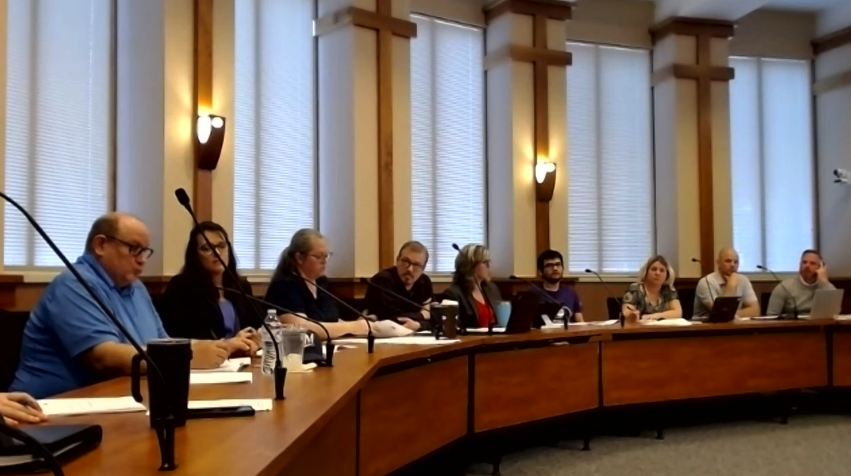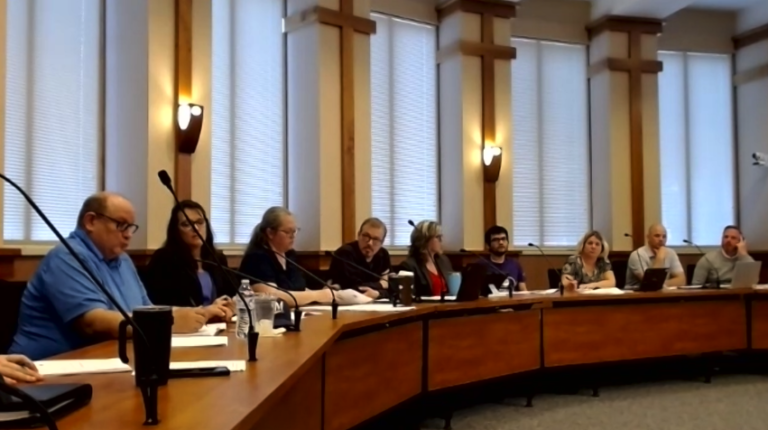Aquatic center subcommittee considers $5 million in improvements; non-binding referendum
- Home
- Aquatic center subcommittee considers $5 million in improvements; non-binding referendum

Aquatic center subcommittee considers $5 million in improvements; non-binding referendum
By Kim McDarison
The Whitewater Aquatic and Fitness Center Subcommittee held its second meeting, Tuesday, April 11, during which each entity that comprises the group — the city of Whitewater and the Whitewater Unified School District — offered considerations from which a contractual negotiation between them might mutually be forged.
A previous contract between the two entities lapsed in 2021.
April 11 marked the second meeting of the subcommittee. A first meeting was held in March.
Among items discussed this month was a report compiled by J.P. Cullen in February at the school district’s request, enumerating some $5 million worth of facility and equipment improvements which, according to school district subcommittee representatives, could be completed within the next five years.
In addition, representatives from the school district expressed a desire to bring costs — including those associated with an existing shortfall, annual operational expenditures, and any agreed upon capital improvements — before its electorate through use of a non-binding referendum question, citing a need to raise taxes to meet any expenses for which it might become responsible, regarding a contractual agreement with the city.
Subcommittee members discussed the potential opportunities for ballot placement of a referendum question, with Whitewater City Manager John Weidl noting that the soonest opportunity would be presented in April of next year.
City council subcommittee representatives expressed a desire to see a lease and operational agreement between the two entities signed sooner, perhaps, subcommittee member Jim Allen said, as early as this fall.
No formal action was taken during the meeting. Instead subcommittee members discussed the capital improvements document as developed by J.P. Cullen and presented by the school district, and identified information needed to continue the process during their next meeting scheduled for May 11.
School district subcommittee representative Larry Kachel was not in attendance during the April meeting.
In an interview with Fort Atkinson Online, Kachel noted that he had resigned his seat on the subcommittee, citing his strong support for the aquatic center, which, he said, could potentially influence his ability to negotiate on the district’s behalf.
School board member Miguel Aranda served as a subcommittee representative during the April meeting.
Also during the meeting, school district Superintendent Caroline Pate-Hefty said that on Monday, the district’s board of education will meet, install new board members and assign committee placements.
School board President Thayer Coburn, who is a member of the subcommittee, did not win reelection in April. His seat on the subcommittee is among those that will be reassigned.
On Tuesday, April 18, newly elected Whitewater Common Council members took the oath of office. Council members each were assigned committee responsibilities, however changes to the subcommittee were not discussed. Subcommittee representatives from the city are Lisa Dawsey Smith, Jill Gerber and Allen who serves as committee chairman. Allen also was elected city council president during Tuesday’s common council meeting.
Increases in annual operational commitments, deficit
Negotiations during the April 11 subcommittee meeting began with language identified by Coburn within the aquatic center’s 2016 contract, which expired in 2021, and was the last one signed by both parties.
During the subcommittee’s March meeting, city officials made two presentations, including a history and overview of the operations and finances of the aquatic center facility.
Within a financial presentation, the city’s Finance Director Steve Hatton noted that in 2022, the city had continued to pay operational expenses even as the facility operated at a revenue loss of $11,598. He cited the COVID shutdown as a contributing factor in revenue losses.
Additionally, the city’s Parks and Recreation Director Eric Boettcher said that over a seven-year period, between 2016 and 2022, the city had made improvements to the center coming at a cost of $395,613.
Boettcher said contributions made by both entities over the years had increased.
Between the time that the facility opened, in 2001, and 2016, he said, each entity, the school district and the city, paid an annual fixed amount of $75,000 toward the functions of the facility.
Beginning in the summer of 2016, he noted, payments from both entities increased to $128,000, with $78,000 spent on operational expenses and $50,000 earmarked to fund capital expenditures.
In 2021, Boettcher noted, with the city and the district being equally responsible for any shortfalls in revenue, the annual support increased by $50,000, for an annual total payment provided by each entity of $178,000.
Hatton said a “mismatched” timing in payments, which each entity was responsible to share, beginning in 2021, began to differentiate and show a shortfall, creating an operating deficit.
The mismatch, both groups agreed, was created by a difference in each entity’s fiscal year.
While the city operates fiscally on a calendar year, the school district’s fiscal year runs from July through June.
According to Hatton, and as shared with the group in March, contributions “weren’t equally paced any longer” and “at the close of 2021, … the acquired deficit since 2016 is $413,000. Once you add the 2022 deficit, we are talking $425,000 on a combined basis,” he said.
Following a shared approach, each entity is responsible for half of the identified deficit.
A story about the first subcommittee meeting, including a breakdown of operating costs and capital expenditures, as provided by the city, is here: https://fortatkinsononline.com/whitewater-aquatic-center-subcommittee-discusses-operations-finances/.
During the April 11 meeting, Coburn noted that there had been discussions within the community that the school district was delinquent regarding its contractual payments.
He said that while the agreement signed between the two entities in 2016 had offered discussion about contributions, it did not address the increases. A subsequent contract between the two entities was never signed.
In the draft contract, dated 2021, the two entities were responsible for splitting expenses, with the school district paying $145,500 for the period of July 1, 2021, to June 30, 2022, and $170,500 for the period of July 1, 2022 to June 30, 2023, and each remaining fiscal year covered by the agreement, and the city was responsible for contributions in the amount of $153,000 for the 2021 calendar year, and $178,000 for each remaining year of the contract.
“So the difference there is just because the district’s fiscal year is July through June,” Coburn said, further noting that the contract stipulated that the amounts contributed by each party could be adjusted on an annual basis if mutually agreed upon by the parties.
Coburn said that over the course of the last three years, he was unaware of the district receiving a specific request for money associated with shortfalls.
Coburn said that in 2016, the district signed a contract making it responsible for half of the shortfall, and while he said he was not philosophically in agreement that the district should be responsible for operational shortfalls, because, he said, it was not involved with day-to-day operations, it was the contract the district signed, and therefore the one by which it should abide, he noted.
“But there needs to be some kind of mechanism for that payment to happen,” he said, adding: “I would recommend, going forward, that there would be some kind of mechanism to ensure that that payment actually does happen and that we don’t get into the situation where the district is considered to be in the arrears or delinquent.”
Hatton said discussions about payments with the district regarding the developing shortfalls were held with previous school district administrations who expressed an interest in covering the shortfalls, which, he said, were accumulated year to year, by making “higher payments and contributions in the future versus a catchup payment.”
“So we weren’t expected to make those payments, is that what I’m hearing?” Coburn asked.
Hatton said the pervious administration had expressed an interest in making higher contributions in the future over time rather than having a bill or paying a lump sum payment to return the aquatic center to solvency.
“And that was the basis and the reason why the draft ’21 agreement to replace the expiring ’16 agreement had higher levels of contribution as they built over time,” Hatton said.
Generating revenue
Pate-Hefty noted that a section in the contract stipulated that the city’s Park Board was responsible for operating the aquatic center “in a way that generates sufficient revenue.”
She added: “I do think that that has to be part of the discussion … I don’t mean that in a pointing fingers direction, because if that’s not something that is reasonable, then I think we need to design a plan in a way that is reasonable. Because the answer can’t be we continue to go to the school district because they are able to levy, because one of the things that our board did say is that they feel strongly that we have promised our taxpayers that we would not increase our taxes. So, when we say, again, we are talking about all these back payments, and what needs to be owed, what is the plan to assure that that doesn’t continue to be the way that we practice?”
Allen suggested that the subcommittee consider creating a new governing board for the aquatic center which could include one member from the city council, one member from the school district, and three members from the public, with each of the three having a particular set of expertise, including “swimming pool experience, somebody with fitness experience, and maybe somebody with marketing experience.”
When the facility was “up and going,” he said, he believed financially it was close to breaking even.
Weidl said be believed the pool’s best year was in 2019, when, he said, “we operated at a deficit of $11,000.”
Dawsey Smith requested that city staff explore state-imposed legal requirements, identifying parks and recreation boards as oversight agencies regarding public amenities, before further exploring the option.
Weidl said he recognized there was a desire to provide more school district and community involvement.
He said he would pursue finding a legal opinion.
Gerber said there already was district representation on the Park Board and residents can attend meetings. Considering the proposed change in the structure, she asked: “How is that going to be different?”
The ‘Cullen report’
Subcommittee members next turned their attention to the report requested by the school district from J.P. Cullen, which itemized a series of improvements that could be made to the facility over the next five years, coming with a total price tag of $5.1 million.
The full itemized report is here: https://www.whitewater-wi.gov/AgendaCenter/ViewFile/Item/7281?fileID=28796.
According to the report, the $5.1 million would include labor, materials and equipment to address several aspects of the facility, including, within the lap pool and the waterpark, the replacement of existing equipment, the building’s roof, exterior building facade and maintenance repairs, exit door maintenance and repairs, the replacement of rusted interior door frames, refinishing the pool floors, replacing the acoustical ceilings, repairing leaking values at the perimeter walls, updating locker room benches, cleaning and patching grout at the pool decks, making upgrades to the HVAC system, and upgrades to lighting.
After receiving the report, Allen asked: “Where did this originate? Did the school board ask for this report?”
Pate-Hefty responded, saying: “It was actually just done mutually, in a discussion, so we had some kind of starting point when we started this process. This is an involved quote. Cullen is a pretty significant school provider that was a part of building the pool in its initial stages, so they were just a starting point so we had some kind of understanding of what numbers we might be looking at for improvements.”
Offering an overview of the report, the district’s Director of Building and Grounds David Friend said that he had “reached out to Cullen and asked them to do an evaluation of the facility.”
Friend said he asked the company to look at the facility to identify needs to be addressed within the next five years.
“These are the budget numbers. It needs to be fine tuned obviously. There could be savings realized from doing both the waterpark and the lap pool at the same time,” he said. He described the $5 million as a “decent budget amount.”
Said Friend: “Based on this report, and just evaluating the facility myself, we’re going to have to figure out how we are going to come up with the money and how soon you want to come up with it.”
He suggested subcommittee members could consider approving projects worth $1 million for each of five years, or “tackle it all together.”
Offering comments from the public podium, Whitewater resident and an organizer of a community-based group called, “Save the Pool,” Geoff Hale suggested that the subcommittee speak with another Save the Pool organizer and area resident Guy Ledwell.
“He knows that pool inside and out, he knows all the functioning workings, about the boilers, and everything, and he’ll be a straight shooter from the standpoint of what has to be done and what doesn’t have to be done,” Hale said.
Hale asked if any of the work could be contracted out to someone local.
Friend said the subcommittee could entertain multiple quotes.
Dawsey Smith said she thought the subcommittee needed to consider a “more granular discussion” about which items were most needed on the list, and who would be responsible for paying for the identified improvements.
“Clearly, as you move through the different pieces of the puzzle, there may be a different burden on one entity over the other with the cost of maintenance longterm,” she said.
Pate-Hefty said that from the district’s perspective, the improvements listed in the Cullen report could be made, give or take, within the next five years. That brought the cost to $1 million each year to continue to update the facility.
Friend noted, that would costs be shared, each entity would be responsible for $500,000 over each of the five years.
Weidl talked about the length of the lease agreement that might be forged between the two entities, noting that some of the items on the Cullen list could have a life of perhaps 20 years. He suggested that the length and structure of a new lease should go beyond the traditional five-year period to acknowledge the city’s longterm investment.
“I could understand there being some future concern on behalf of the council going, ‘well, we are on a five-year plan, with a five-year lease, to put in equipment that will last much longer than that,’ and I don’t think that represents a concern other than we really do want to make sure, as any tenant would, that the amount we are putting in reflects also the length of service we are getting out of the equipment, which can be done very easily using a depreciated model,” he said.
Allen, Dawsey Smith, and Coburn said they would be in support of a lease period that was longer than five years.
Speaking from the public podium: Ledwell said he was aware of costs associated with items on the Cullen report’s list.
He suggested there could be a cost savings if the city or school district was able to do some of the installation work themselves.
He told subcommittee members that he thought some of the prices were high, calling them a good representation of a “worst-case scenario.”
“I guess what I’m saying is that there’s adequate money for everything in here,” he said.
Looking at the life of certain pieces of equipment, he said a “rule of thumb” was between 10 and 15 years.
Referencing equipment in the aquatic center, he said, “There isn’t anything in that room that probably has a life expectancy of 20 years right now, not to say it won’t last 20 years, but nobody would put a life expectancy of 20 years on it. A lot closer rule of thumb might be 12.”
Dawsey Smith asked the subcommittee to allow the city time to “confer on the items listed in the quote,” adding that she was not necessarily looking at the individual costs of each item, but she was more interested in looking at the necessity of each item and developing a “horizon of repair needs.”
Pate-Hefty said the district would be willing to “sit down and look through that.”
Dawsey Smith said that a quote, which might be more representative of the time in which the future work would be contracted, also might be valuable.
“We have a quote in front of us that may or may not be accurate at the time that the work needs to be done. It would be more productive for us to have just an agreed upon list of facility needs in general,” Dawsey Smith said.
Weidl outlined a traditional request for proposals process used by municipalities.
“If it were solely a city project, what we would be doing is a request for proposals. We would have all of these projects on a list and we would be asking companies to respond within a timeline, and typically, all of those are opened in a public setting at the same time.
“Now that’s a longer process than getting down to what we might need to use for a contract. Generally that’s the form we follow in local government,” he said.
Allen suggested that the group might confer with Ledwell, saying: “We are all very lucky to have his expertise right here in Whitewater.”
Solvency, taxes, non-binding referendum
Looking at the deficit that has accrued, Gerber asked Hatton for how long the city could continue to carry that debt.
Said Hatton: “Within the city’s treasury we have the ability to carry this debt, but it’s not ideal. Ideally we would have had an annual payment so that this remains solvent at the close of any fiscal year.
“That hadn’t been done, and from previous conversations with the district, the preference was just to increase payments over time, not to make a lump sum payment to bring it back to a zero balance as it had annual operating deficits,” he said, adding: “The clear preference would be pay it back to a zero fund balance by both parties and then address it year-to-years so it doesn’t accumulate into something sizable.”
Allen asked if both sides would be interested in going back to a zero fund balance.
Whitewater Unified School District Director of Business Services Ben Prather said that the district would need to increase taxes paid by its constituents to return the fund to a zero balance.
“The only way we pay for this is by increasing Fund 80, which is on top of the tax levy. So taxes would be going up if we were to pay off this large sum. I think probably that’s why the strategy was to chip away at it. My challenge with that strategy is we didn’t know what deficit we were going to walk into the following year, (and) the following year, it was kind of just guessing at how much we are going to increase, and hopefully that was more than what that year’s deficit addition would be. From my perspective, presenting this to the school district, I would be uncomfortable raising taxes without getting feedback from the community,” he said.
Said Weidl: “On the city side, our fund balance would most likely take care of it and then we would move on and decide how we would deal with any annual contributions of the new contract holistically moving forward.”
He added: “We are fortunate enough to have a no lower than 20% fund balance as policy requires, and that would be something we think about. Now certainly we could go about it another way. We do, on the city side, have an option to come to zero on the fund balance ledger without directly increasing taxes year-over-year.”
When asked about information that might help the district make negotiating decisions, Prather said a big help for him would be an understanding of costs.
“I think we went to an outside firm like Cullen to understand, you know, how much are we going to bite off here? So we can actually budget and plan for, and know, what’s going to be doable … it wasn’t to undercut anyone, it was just like, ‘let’s get an idea where we are at,’” he said.
He said having an idea about maintenance costs over a 5- and 10-year period would be helpful.
Addressing Boettcher, he said: “I know COVID kind of threw up membership, a lot, Eric, and so it’s hard to have a consistent projection of where we are going to be in three years, and how many memberships we are going to sell, but that kind of business plan would also be helpful.”
Pate-Hefty said that even though the community did not use ESSER funds to pay for the district’s field, it did use monies from the district’s fund balance.
“We’ve been really proud that we can offer those fields for a variety of reasons, including things that are for instructional purposes, and yet our board has taken a lot of flack for that. And so that’s a balance that we’re now making a decision about,” she said, noting that she believed board members would need to ask: “Does our community value in the same way updating our facilities? And so I think that that’s something that really pushes us to say, and not that we don’t want to, but: Do we need to go to our community to ask this question?”
She said lessons learned with the money spend on the fields, even though it did not raise taxes, has created some “reluctancy” on the part of the school board to spend money that will increase taxpayer dollars.
Looking at funding for the aquatic center from the school district side, Prather said: “This would be coming out of our Fund 80. So, as a cost, increments would increase generally over time given inflation, all of those things, it would be directly on the tax bill.”
He said he thought placing a non-binding referendum question on a future ballot to ask the taxpayers if they would support the increase, had “merit.”
“I would have, in principle, I would have a lot more ease if we did ask our community before we saw taxes increase,” he added.
Weidl pointed out that the next opportunity to have a referendum placed on a ballot is April of 2024.
Gerber noted that if the subcommittee waited for the results of a non-binding referendum, a contract for the aquatic center might not be negotiated for another year.
Pate-Hefty said the school board promised its constituents it would not raise taxes. She described herself and Coburn as “the face” of that promise.
She said the non-binding referendum question would allow them an opportunity to ask taxpayers for the increase and explain why it’s needed.
Gerber asked if the district was willing to sign a contract with the city before it went to referendum.
Said Prather: “I think it is reasonable to build a bridge if we need to to April (2024). Citing the two years that the entities have already operated without a contract, he said, “I think it would be reasonable to limp along, for a lack of a better term, to get us through, and then that would also give the body enough time to really hatch out a well-defined contract.”
Additionally, the group discussed hiring a facilitator to help it complete the negotiation process.
Members agreed pursuing a facilitator was premature.

Members of the Whitewater Aquatic and Fitness Center Subcommittee, including city council representative and subcommittee chair Jim Allen, from left, city councilwoman Jill Gerber, city councilwoman Lisa Dawsey Smith, school board president Thayer Coburn, school district Superintendent Caroline Pate-Hefty, school board member Miguel Aranda, school board member Jen Kienbaum, school district Facilities and Grounds Director David Friend and school district Finance Director Ben Prather, meet on April 11. Also present, but not pictured, were City Manager John Weidl, and city staff members Director of Parks and Recreation Eric Boettcher, and Director of Finance Steve Hatton. The next subcommittee meeting will be held May 11. Weidl announced Tuesday during the Whitewater City Council meeting that Hatton has offered his resignation and has accepted a job with Sheboygan County. Screen shot photo.
This post has already been read 662 times!
Kim
Our Advertisers
Most Read Posts
- No results available
Categories
- Advertisers
- Area events
- Art, culture
- Business
- Community
- County
- Crime, court
- Culture
- Diseases
- Economics
- Food
- Government
- International
- Law and Court
- Lifestyle
- Obituaries
- Opinion
- Police, fire, EMS
- Religion
- School
- Science
- Technology
- Today's features
- Today's news
- Top Stories
- Travel
- Uncategorized
- University
- World











